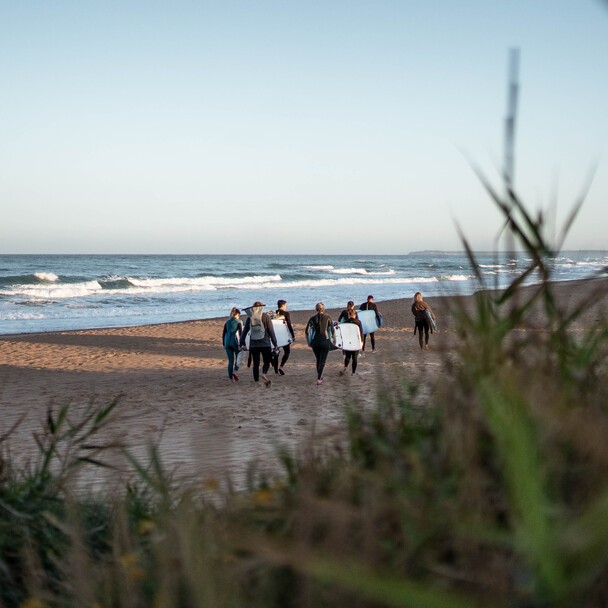Surfspot Check - The ultimate guide

- Introduction
- Definition Surfspot Check
- Die Grundlagen des Surfspot Checks
- 1. wind conditions at the surf spot
- Offshore
- Onshore
- Sideshore
- No wind (glassy)
- Tip about Swell Forecast & Wind Radar
- 2. Tides and currents
- 3. Shaft types and sizes
- 4. Dangers and annoyances at the surf spot
- Conclusion Surfspot Check
Introduction
All surfers know the situation: you're standing at a beautiful surf spot and want to get into the water straight away. But just walking into the water and paddling off is not the smartest thing to do. In our surf courses, we do a so-called surf spot check before every surf lesson. The spot check gives us an overview of the conditions in the water so that we can recognize and avoid any dangers. With a surf spot check, you can recognize dangers and get the best out of your surf session. We'll show you how to do a surf spot check here.
Definition Surfspot Check
What is a surf spot check and why is it important?
A surf spot check is a systematic assessment of the surfing conditions at a specific location. This assessment helps you to find the ideal time and place to surf. A thorough surf spot check can:
Increase your safety by recognizing dangers such as strong currents or rocky bottoms.
Improve your surfing experience by selecting the optimal conditions for your skill level.
Help you find the best waves and therefore have more fun in the water.
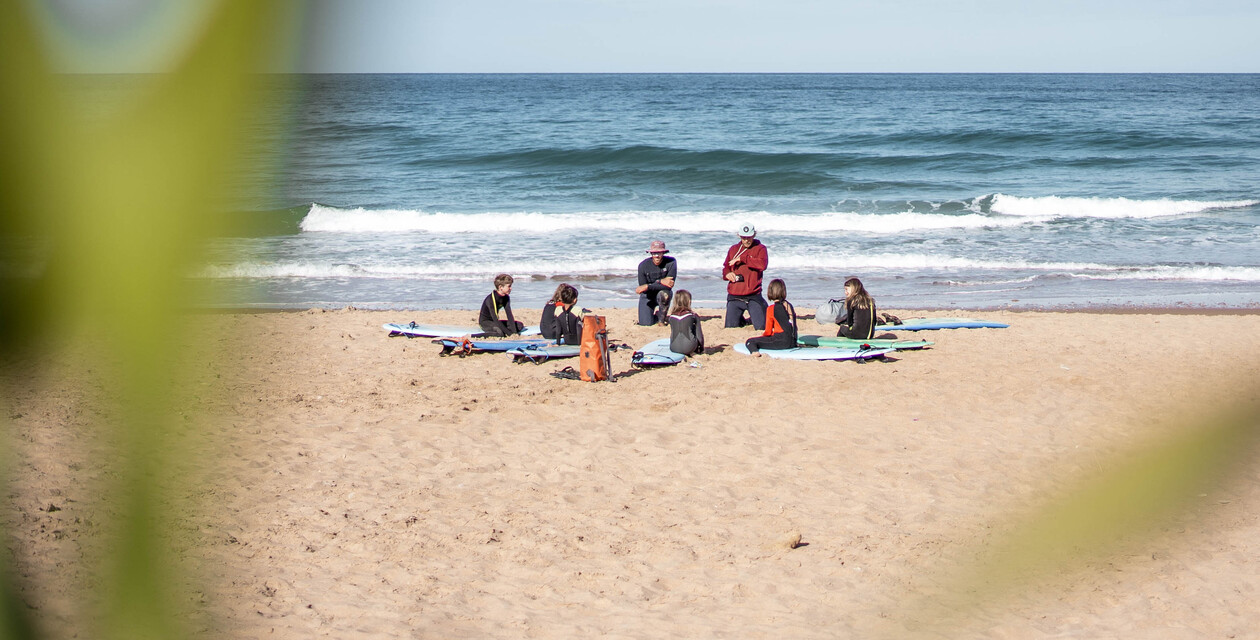
Die Grundlagen des Surfspot Checks
Ein gründlicher Surfspot Check ist essenziell, um sicher und effektiv zu surfen. In diesem Abschnitt betrachten wir die wichtigsten Grundlagen, die du kennen musst: Wellenarten und -größen, Strömungen und Gezeiten sowie Windbedingungen und ihre Auswirkungen.
1. wind conditions at the surf spot
Whether and from which direction the wind is blowing is a decisive factor when surfing. You can usually observe the following wind directions at a surf spot:
Offshore
The preferred wind for surfers is the offshore wind. In this case, the wind blows from the land out to sea. This creates waves that are very clean and makes the waves run for a long time. Clean means that the water looks like it has been ironed smooth and you can recognize the waves rolling in from a distance. You can therefore concentrate on the wave early on and get into the right position to catch the wave.
In addition, the wind blows into the breaking wave, which means that the wave breaks evenly in one direction or the other - and allows you to surf for a long time. Offshore waves are usually rather steep. If you're in the right part of the wave, this often makes for a fast ride.
Disadvantage for beginners
The disadvantage for many surfing beginners is the more difficult timing. The window between: I-can't-catch-the-wave-yet-because-it's-still-too-flat and the-wave-is-already-too-steep-for-me-to-make-the-take-off, gets smaller due to the offshore wind. This means you have to paddle the wave with an extra portion of commitment. You have a headwind when paddling and the wind pushes you out of the wave. Dealing with these conditions requires a bit of practice, but after a few attempts you'll usually understand how to surf these offshore waves.
Tip: When sitting in the line-up, make sure you don't get blown too far out by the wind. Always take a few paddle strokes towards the beach to avoid being blown out of position. A good sign of offshore wind is the so-called spray, which is blown backwards by the lip of the wave. Such a sight makes surfers' hearts beat faster.
Offshore wind phenomenon
Especially in the tropics (or in winter here in El Palmar), the land mass cools down more at night than the ocean. To balance this temperature and pressure equalization, local areas of high and low pressure develop. The cold air flows from the land to the warmer sea, creating the popular offshore breeze early in the morning. When the land heats up again during the day due to the sun and the temperatures of the sea and land mass equalize, this effect fizzles out and the offshore wind is gone. During the course of the day, the land heats up so much that it becomes significantly warmer than the sea. This means that the effect is now reversed: The air flows from the sea onto the warmer land and onshore wind is created. As a surfer, it is therefore advisable to get up early and hop into the water before breakfast to catch a few waves. Sometimes it's a bit tough, but it's often worth it - because: "The early bird catches the worm." ;-)
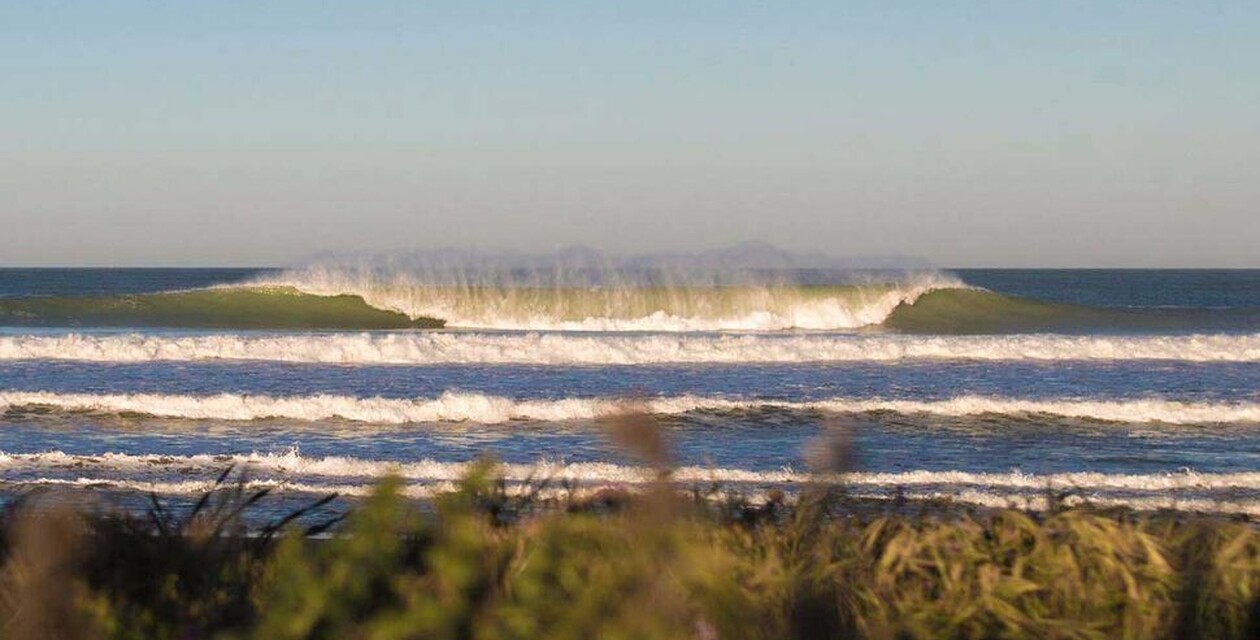
Onshore
With onshore wind, the wind blows from the sea to the coast. This usually brings choppy waves with it, which are more difficult to read: It's harder to tell when and where the waves are breaking. This means that in onshore conditions, the waves are relatively messy, but they are not necessarily bad conditions.
Advantage for beginners
Because the wave breaks earlier but does not collapse as steeply, you have more time for your take-off. And this factor in particular makes it much easier to surf the wave - especially in the early stages. It can also be the case that the waves break further out and come rolling in as a white water roller. If you decide to take this wave, you are often rewarded with a so-called "rebuild". The white water wave suddenly builds up again as a green wave and you can actually surf it parallel to the beach. So you take off in white water and are then pushed into a green wave. These are some of the advantages of surfing in onshore conditions.
Here you can see typical onshore conditions. In contrast to offshore wind, onshore conditions are not as clean and clear.

Sideshore
Of course, there are also winds that blow into the wave from the side. Depending on whether the wind blows cross-on or cross-off, they have similar characteristics to the wind types mentioned above. It also always depends on how the beach is oriented and which sideways wind direction is more favorable for the spot.
No wind (glassy)
Less wind is also a very popular scenario for surfing. Especially early in the morning, there may be almost no wind at all. warmer months, when the nights are milder and the sea and land mass are almost the same temperature in the morning. When there is no wind, it is called glassy. The waves run cleanly over the sandbanks without being affected by the wind. The sets are also easily recognizable from a distance. When there is no wind, this is called glassy. The waves run cleanly over the sandbanks without being influenced by the wind. When there is no wind, the sets are again easily recognizable from a distance.
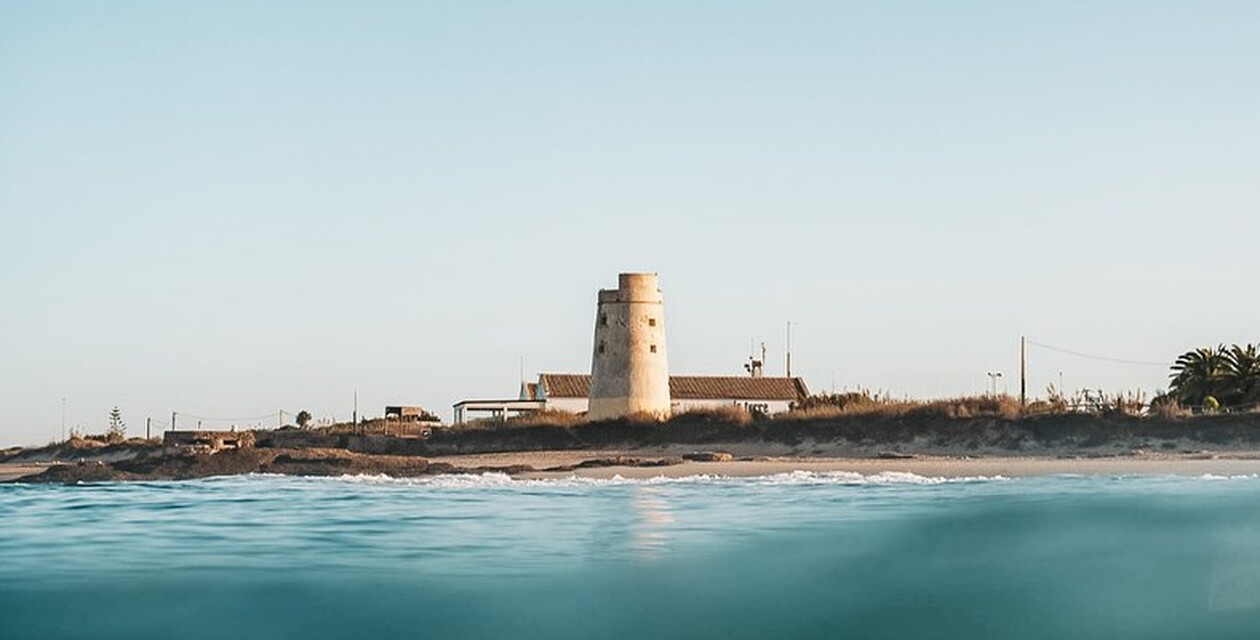
Tip about Swell Forecast & Wind Radar
To check the wind, wave height, period and tide level in advance, there are websites with wave forecasts. The so-called forecast or surf report provides an overview of many relevant factors. It also gives an outlook on how the waves and surfing conditions could turn out. As with the weather forecast, the surf forecast is not 100% accurate. It is not a substitute for looking out to sea. This is unbeatable, as local winds or conditions that affect the waves are difficult to predict. Nevertheless, a surf report can give you a good overview of the upcoming conditions. Well-known sites are Surf-Forecast.com or Surfline.com. A good wind radar can be found at Windy.com. Here, current conditions such as wind, waves, temperature, etc. are displayed and animated.
2. Tides and currents
Currents:
Rip currents: These dangerous currents can pull surfers out to sea. It's important to recognize them and know how to get out of them - swim parallel to the coast until you're out of the current.
Longshore currents: These currents run parallel to the coast and can carry you away from your original spot. Watch out for landmarks to keep your position.
Tides:
The tides play a major role at the surf spot alongside the wind. Ebb and flow: controlled by the moon and the sun, they influence the quality and breaking behavior of the waves. There are two main tidal phases:
High tide: Many surf spots work better at high tide as the waves are less steep and powerful.
Low tide: Some spots offer hollower and faster waves at low tide. Find out about the tide schedules and how they affect the waves at your spot.
High Tide & Low Tide
It takes 6 hours from low tide to high tide and vice versa, and this shifts back by a good hour every day. So if we have high tide at 6 am today, you can expect it to peak at around 7 am tomorrow. To find out more about this, you are welcome to visit our wave theory during your surfing vacation with us in El Palmar. We go into more detail there.
The tidal range
Tidal ranges vary in strength: on days with a full or new moon, the tidal differences are greater than on days with a half moon, for example. This has to do with the fact that the sun, earth and moon are in line at full or new moon and the gravitational forces add up. At half moon, the stars are offset from each other and there is less water in motion, meaning the tidal range is not as pronounced.
This is why tides are important for surfing
To better understand why the tide is so important for waves when surfing, here is a small example: Imagine the wave as an iceberg. Most of the energy is underwater, the tip of the iceberg is the wave.
At low tide, the wave energy from deep water hits the sandbank. As a result, the lower part of the wave is abruptly slowed down and thrown forward. This wave is rather unfavorable for intermediates and beginners because it breaks very quickly and hollow. Experienced surfers can perhaps have fun here and try to catch a tube. For all other surf levels, however, such a wave is not yet highly recommended, as this wave is difficult to surf.
What happens now? Three hours pass, the water rises and the same sandbank is now hit much more gently by the wave. The wave no longer breaks so hollow, but slower and flatter than before. Now you can glide calmly into the wave and have no stress with the take-off. These are the conditions for us!
Another 3 hours later, we have high tide. The sandbank is no longer hit by the wave energy and rolls through until the beach gets in the way and the wave breaks on the sand as a so-called shorebreak. This surf spot is therefore not a high-tide spot. It's not surfable.
As you can see, the tide completely changes the character of a wave. That is why it is so important to know at which tide level it is favorable to surf. This can be different for every surf spot. Depending on the nature of the ground and sandbanks.
Conclusion
When checking the surf spot, it is important to check how the tide will behave during surfing.
By the way: We always adjust our surf course times to the tide in order to create optimal conditions for our surf students. If you are our guest, you can of course always ask us when the best time to surf is. Or visit our wave theory. There you will learn how to read a surf forecast. Then you can check the swell report in El Palmar yourself every day :)
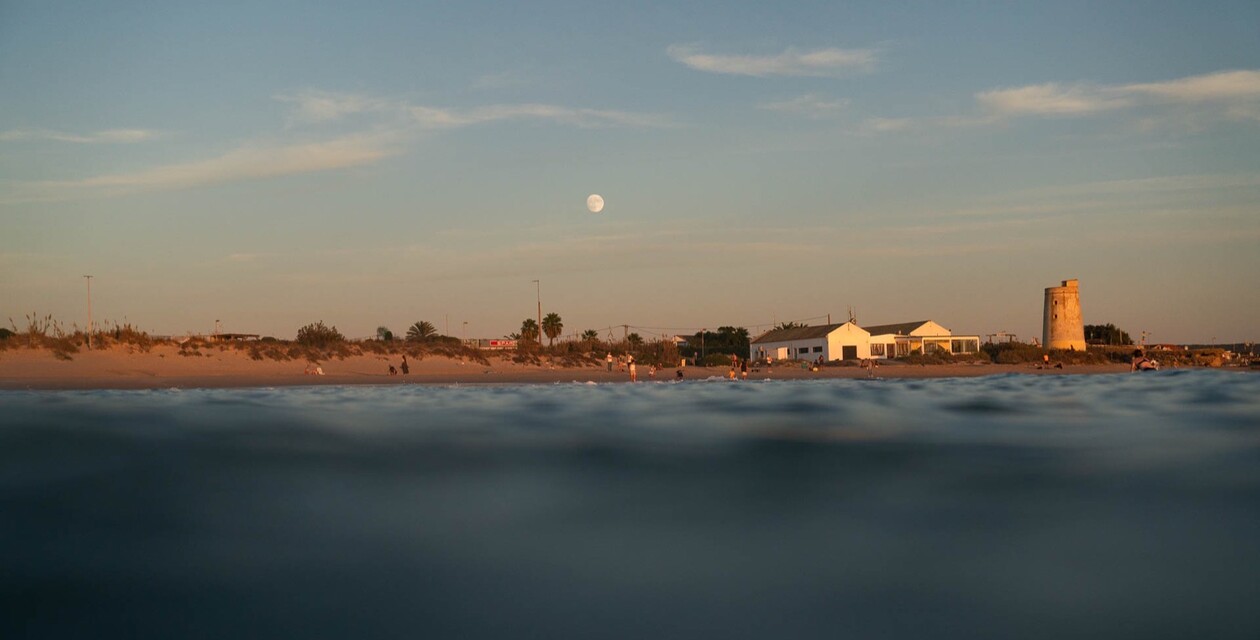
3. Shaft types and sizes
An important factor when you're standing on the beach and checking out the surf spot. After all, it makes a difference whether bus-high waves roll in or whether cozy waist-high waves invite you to have fun.
Wave types:
Beach breaks: These waves break over a sandy bottom and are often unpredictable, as the sandbanks are constantly shifting. Beach breaks are ideal for beginners and offer a variety of wave shapes.
Reef Breaks: These waves break over a reef or rocky bottom. They are more consistent and can produce powerful, hollow waves that are suitable for advanced surfers.
Point Breaks: These waves break on a headland or cape and roll along the coast. They offer long, consistent waves and are very popular with many surfers.
Wave sizes: The size of the waves depends on the wind strength and duration as well as the distance of the storm from the surf spot. Smaller waves (up to 1 meter) are ideal for beginners, while larger waves (over 2 meters) require more experience and skill.
How is the wave height measured?
The size of the waves depends on the wind strength and duration as well as the distance of the storm from the surf spot. Smaller waves (up to 1 meter) are ideal for beginners, while larger waves (over 2 meters) require more experience and skill.
The wave height is measured in meters, feet or body parts. The latter makes it easier to estimate the height from the wave trough to the lip of the wave (the wave trough is at the bottom, the lip at the top). Estimating the wave height from the beach is sometimes difficult. Estimates often vary widely. Especially when talking to surfing newbies who come back from a good surf full of adrenaline, a chest-high wave often turns into a head-high wave.
So it's like fishermen with the length of the fish they catch: we surfers tend to exaggerate. ;-)
Wait for big sets
You should still learn to classify the waves for yourself in order to be better prepared for the conditions that await you out in the line-up. Especially on days when big waves with a long wave period are forecast, it's worth looking at the sea a little longer before you decide to paddle out. Due to the long way this swell has traveled, the waves have organized themselves in such a way that the big set waves (wave groups) only roll in every few minutes. But then with tremendous force. So it's not enough to grab your surfboard and paddle out after 30 seconds of looking out to sea. This can result in you not having seen the set at all and being "smashed" with the next set. Take your time and wait until you have seen a few sets and can estimate the wave height.

4. Dangers and annoyances at the surf spot
Dangers at the surf spot include currents, rocks, shallow reef, fishermen and other surfers. The following situations can occur:
No one is in the water to surf
Imagine you arrive at a surf spot, the conditions look great but no one is surfing. Always start by asking yourself why no one is in the water. Maybe there are lots of jellyfish in the water, it's dirty or full of sea urchins. If you can't judge for yourself, ask one of the locals or a lifeguard why there is no one in the water today. This way you can play it safe and avoid danger. If everything is in order, you'll have the sea to yourself. That's nice too. :-)
Fishermen fishing at the surf spot
Fishermen live with the sea, just like us surfers. Nevertheless, fishermen can sometimes be exhausting because they often fish exactly where the best wave is breaking. The fishermen often fish exactly where the waves are breaking. And that makes sense, because that's where the best fishing opportunities are. So swallow your anger, say hello in a friendly manner and show understanding and respect. Fishermen are beach users just like you.
Other surfers
Other surfers can also pose a danger at the surf spot. For example, it can happen that the line-up is quite crowded. Not every surfer has their surfboard under control. Beginners in particular still need to practise, of course. It can happen that a surfboard flies into the air, you get hit by a fin, someone rides over your surfboard or a surfer is in the surf zone and therefore in the way. So always watch out for other surfers. This way, you can minimize the risk of injury and concentrate on having fun while surfing.
Our tip: Learn the rules of right of way and try to stay away from crowded surf spots. If a surf spot is a beach break, you can switch to another sandbank if necessary. The wave may not be as perfect there as at the crowded surf spot, but the wave yield and the fun will probably be greater.
Other surfers can also be of help: Ask them for tips about the surf spot such as currents and special features. As a rule, surfers are collegial and help each other.
Are you in the right frame of mind today?
On days with very good surfing conditions and big waves, look inside yourself and be honest with yourself. Ask yourself the following questions:
Am I ready for these waves yet?
Do I know what to do in case of danger?
Do I feel good enough today to take on this challenge?
Even among good surfers, it depends on the day whether they venture into big waves or prefer to stay on the beach. The mindset has to be right and there's no shame in saying: "It's too big for me today". Of course you have to test your limits. It's also a lot of fun to move outside your comfort zone and find out where your limits are. However, false ambition is out of place here. Always make sure that you are not a danger to others or yourself.
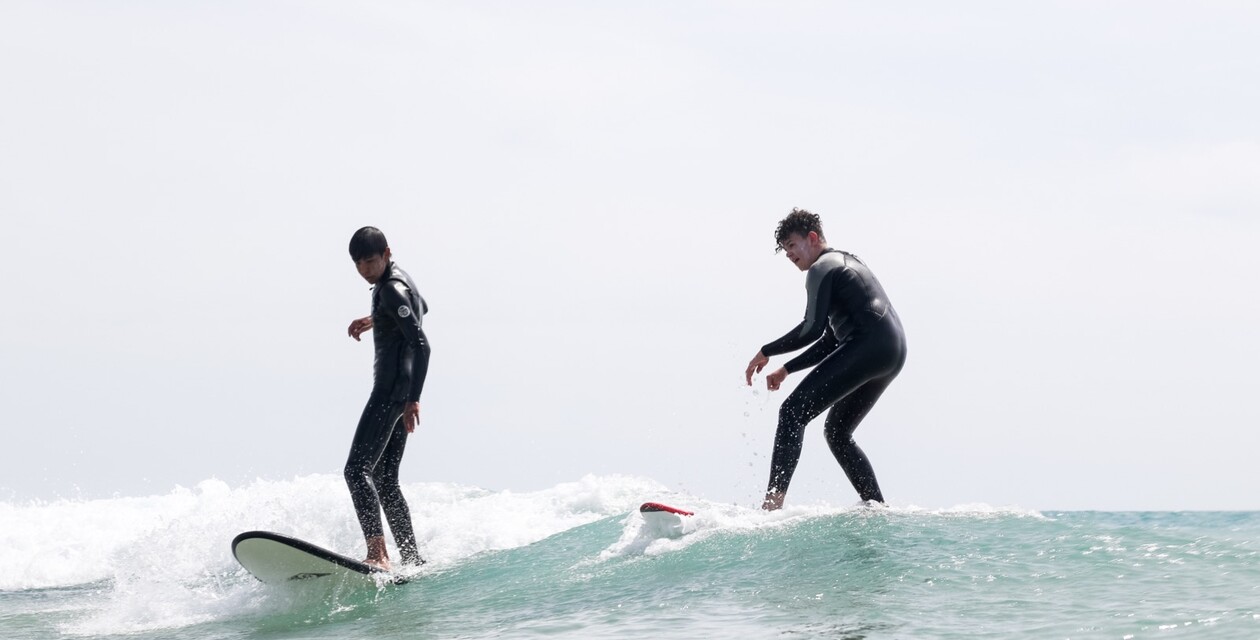
Conclusion Surfspot Check
These are the things you should think about before you throw yourself into the waves at a surf spot. It sounds like a lot of work, but with prior knowledge and experience, it can be done quickly. Any information you glean from your observations can help you become a better surfer. You'll feel more confident and have more fun in the water - that's a promise. Also, don't be afraid to ask other surfers if you're not sure about certain conditions. Especially on a surf vacation, you don't know the surf spot yet. There are usually lots of surfers who know the spot better and can give you useful tips.
